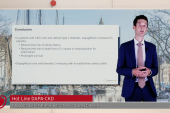EMPA-KIDNEY: Empagliflozin a ‘Win’ for Patients With CKD
For patients with kidney disease, “the point is: get them on the gliflozin that they can be on,” Janani Rangaswami says.

CHICAGO, IL—Among patients with chronic kidney disease (CKD) who are at risk for progression, yet another sodium-glucose cotransporter 2 (SGLT2) inhibitor has been shown to improve clinical outcomes.
In the EMPA-KIDNEY trial, empagliflozin (Jardiance; Boehringer Ingelheim/Eli Lilly) reduced the primary composite endpoint of kidney disease progression or cardiovascular death versus placebo (13.1% vs 16.9%; HR 0.72; 95% CI 0.64-0.82), with consistent findings irrespective of preexisting CVD.
Empagliflozin also cut the risk of all-cause hospitalization (HR 0.86; 95% CI 0.78-0.95), David Preiss, PhD (University of Oxford, England), reported here at the American Heart Association (AHA) 2022 Scientific Sessions.
A number of secondary cardiovascular endpoints were not significantly reduced with active treatment, although the investigators note that a lack of statistical power stemming from lower-than-expected event rates could be to blame. They point out, too, that the hazard ratios all signal a benefit with empagliflozin, consistent with trials of other SGLT2 inhibitors, such as DAPA-CKD and CREDENCE.
Indeed, Preiss reported, when the EMPA-KIDNEY results were pooled with data from those and other trials that evaluated SGLT2 inhibitors in various high-risk groups—including those with diabetes and high CV risk, heart failure (HF), or CKD—treatment with the agents consistently improved both renal outcomes and cardiovascular outcomes, including CV death and a composite of CV death or hospitalization for heart failure.
Responding at a press conference to a question about whether differences in the results of the DAPA-CKD and EMPA-KIDNEY trials indicate differential effects of dapagliflozin (Farxiga; AstraZeneca) and empagliflozin, Preiss highlighted the totality of the evidence from all SGLT2 inhibitor trials, including those in the setting heart failure, to downplay potential differences between the drugs.
“My own view is that both of these drugs, or indeed the class of drugs I should say, is going to be of substantial benefit to these patients, and I would struggle to draw a line between them,” he said.’
My own view is that both [dapagliflozin and empagliflozin], or indeed the class of drugs I should say, is going to be of substantial benefit to these patients, and I would struggle to draw a line between them. David Preiss
Janani Rangaswami, MD (George Washington University, Washington, DC), agreed, noting that outcome definitions and baseline characteristics were not entirely consistent across trials. “This is one of the fields where we have really done well, I think, as a heart-kidney community in terms of validation studies and just not going with one groundbreaking trial, but again and again [demonstrating] the very consistent benefits for heart failure and end-stage kidney disease and all the other cardiovascular outcomes,” she said. “So I really think the point is: get [patients] on the gliflozin that they can be on.”
Some of the EMPA-KIDNEY results had already been presented Friday at the American Society of Nephrology’s Kidney Week, with the main results published at that time in the New England Journal of Medicine. The meta-analysis was published simultaneously online in the Lancet to coincide with Preiss’ AHA presentation.
EMPA-KIDNEY
The EMPA-KIDNEY trial, conducted at centers in eight countries, enrolled patients with CKD who were at risk of disease progression, defined as an estimated glomerular filtration rate (eGFR) of 20 to < 40 mL/min/1.73 m2 or an eGFR of 45 to < 90 mL/min/1.73 m2 plus a urinary albumin-to-creatinine ratio ≥ 200 mg/g. They were randomized to empagliflozin 10 mg once daily or placebo.
There were 6,609 patients (mean age 64 years; 33% women), with a mean eGFR of 37 mL/min/1.73 m2, which is “considerably lower than has been achieved in any previous trial of these drugs,” Preiss noted. The proportion of patients without diabetes (54%) also was lower than in comparable trials. Overall, 26% had preexisting CVD.
The primary outcome was a composite of CV death or kidney disease progression, which included end-stage kidney disease, renal death, or sustained eGFR declines (of ≥ 40% or to < 10 mL/min/1.73 m2). Empagliflozin reduced this endpoint through a median follow-up of 2 years.
All-cause hospitalizations also were significantly reduced, which is important because the risk of hospitalization is so high in patients with CKD, Preiss said.
As for secondary cardiovascular endpoints, there were only nonsignificant trends toward lower risks of HF hospitalization (HR 0.80; 95% CI 0.60-1.06), CV death/HF hospitalization (HR 0.84; 95% CI 0.67-1.07), and MACE (HR 0.93; 95% CI 0.76-1.12). All-cause death, too, was not significantly different between the empagliflozin and placebo arms (4.5% vs 5.1%; HR 0.87; 95% CI 0.70-1.08).
SMART-C Meta-analysis
To give a broader view of the impact of SGLT2 inhibition, Preiss also presented the results of a pooled analysis from the SGLT2 inhibitor Meta-Analysis Cardio-Renal Trialists’ Consortium (SMART-C), which incorporated data from the 13 placebo-controlled trials conducted in various patient populations—five in heart failure, four in CKD, and four in high-risk type 2 diabetes. Overall, there were 90,413 patients, of whom 83% had diabetes.
SGLT2 inhibition reduced both renal and cardiovascular outcomes, including:
- Kidney disease progression (relative risk [RR] 0.63; 95% CI 0.58-0.69)
- Acute kidney injury (RR 0.77; 95% CI 0.70-0.84)
- CV death (RR 0.86; 95% CI 0.81-0.92)
- CV death or HF hospitalization (RR 0.77; 95% CI 0.74-0.81)
Results were consistent irrespective of diabetes status and clinical setting, although confidence intervals around the estimates were wider when it came to nondiabetic patients with CKD due to limited data.
“This meta-analysis provides high-quality evidence to support guideline recommendations for the use of SGLT2 inhibitors as a foundational therapy to reduce the risk of kidney disease progression and acute kidney injury not only in patients with type 2 diabetes at high cardiovascular risk, but also in patients who have chronic kidney disease or heart failure, irrespective of diabetes status, primary kidney diagnosis, or level of kidney function,” the authors conclude in the Lancet paper.
‘Very Welcome Addition’
Discussing the results at the press conference, Rangaswami said EMPA-KIDNEY builds on the signals of kidney and heart protection observed in prior landmark trials of SGLT2 inhibition, including DAPA-CKD and CREDENCE. She highlighted that about a third of participants had an eGFR below 30 mL/min/1.73 m2, noting that there are not many therapies that can be started in this situation: “This is a win for patients with CKD [stage] 4.”
Ultimately, Rangaswami said, “I think this is a very welcome addition to the already very strong body of evidence that we have. And to paraphrase Dr. Braunwald: the SGLT2 inhibitors are the statins of the 21st century.”
To paraphrase Dr. Braunwald: the SGLT2 inhibitors are the statins of the 21st century. Janani Rangaswami
She acknowledged that uptake of the agents has been low, particularly among nephrologists, since dapagliflozin was approved by the US Food and Drug Administration for use in CKD in May 2021, and said she hopes EMPA-KIDNEY will provide a boost in prescriptions.
Patrick Mark, PhD, and Naveed Sattar, MD, PhD (both from the University of Glasgow, Scotland), pick up that thread in an editorial accompanying the Lancet paper.
“Nephrologists should now work with and empower primary healthcare providers to ensure that SGLT2 inhibitors are implemented as a foundational therapy for chronic kidney disease, with early initiation in individuals at risk of chronic kidney disease progression to minimize the risk of kidney failure and its associated cardiovascular complications,” they write. “The robust cardiorenal benefits now being observed were not widely predicted when the first SGLT2 inhibitors were being trialed, showing once again the importance of randomized trials and scientific humility in medicine. Ongoing trials with SGLT2 inhibitors suggest their clinical reach might expand further.”
Todd Neale is the Associate News Editor for TCTMD and a Senior Medical Journalist. He got his start in journalism at …
Read Full BioSources
The EMPA-KIDNEY Collaborative Group. Empagliflozin in patients with chronic kidney disease. N Engl J Med. 2022;Epub ahead of print.
The Nuffield Department of Population Health Renal Studies Group and the SGLT2 inhibitor Meta-Analysis Cardio-Renal Trialists’ Consortium. Impact of diabetes on the effects of sodium glucose co-transporter-2 inhibitors on kidney outcomes: collaborative meta-analysis of large placebo-controlled trials. Lancet. 2022;Epub ahead of print.
Mark PB, Sattar N. Implementation, not hesitation, for SGLT2 inhibition as foundational therapy for chronic kidney disease. Lancet. 2022;Epub ahead of print.
Disclosures
- The EMPA-KIDNEY trial was initiated by Oxford Population Health (the Nuffield Department of Population Health at the University of Oxford), which led its design, analysis, and reporting with a steering committee of expert collaborators. The trial was funded and sponsored by Boehringer Ingelheim, with additional support from Eli Lilly and the UK Medical Research Council.
- Trials contributing to the SGLT2 Inhibitor Meta-Analysis Cardio-Renal Trialists’ Consortium (SMART-C) were funded by various pharmaceutical companies.
- Preiss reports no relevant personal conflicts of interest.
- Mark and/or Sattar report having consulted for and/or received fees for lectures on SGLT2 inhibition from Napp, Merck Sharp & Dohme, AstraZeneca, and Boehringer Ingelheim, and receiving grant funding paid to the University of Glasgow for SGLT2 inhibition trials from Boehringer Ingelheim and AstraZeneca. Unrelated to SGLT2 inhibition but related to chronic kidney disease and cardiometabolic diseases, Mark reports having consulted for Vifor, Pharmacosmos, GlaxoSmithKline, and Astellas. Sattar reports having consulted for and/or received lecture fees from Abbott Laboratories, Afimmune, Amgen, Boehringer Ingelheim, Eli Lilly, Hanmi Pharmaceuticals, Janssen, Novartis, Novo Nordisk, Pfizer, and Sanofi, and receiving grant support paid to the University of Glasgow from Novartis and Roche Diagnostics.





Comments